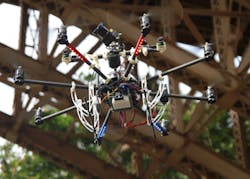Carnegie Mellon to develop robots for bridge inspection, surgery
The National Science Foundation has awarded a $7 million grant to Carnegie Mellon researchers in order to develop seven new research projects, including robotic rotorcraft for inspecting bridges, assistive robots for blind travelers, and autonomous robots which serve as scouts for rescuers responding to underground mine disasters.
The grants come from a multi-agency initiative aimed at developing robots which can work with humans to extend and augment human skills, according to a Carnegie Mellon press release. One of the projects that the Carnegie Mellon Robotics Institute will work on is an autonomous robot inspection assistant which, if proven to be successful, would improve the assessment of aging bridges.
Small, low-flying robots would be coupled with 3D imaging and advanced planning, modeling, and analysis to provide safe, efficient assessment of critical infrastructure, according to Sanjiv Singh, research professor at Carnegie Mellon’s Robotics Institute. This three-year, $2.3 million project includes researchers from Carnegie Mellon and Northeastern University.
A separate, multi-university project will provide surgical robots with a new type of machine intelligence which will enhance minimally invasive surgeries. The five-year, $3.6 million project includes researchers at Vanderbilt University and Johns Hopkins University. This project will take advantage of a robot’s ability to gather sensory information as it works and to use that information to guide its action. It will use a technique called simultaneous localization and mapping (SLAM) which allows mobile robots to navigate unexplored areas by creating maps as they work.
Additional robotic projects at Carnegie Mellon include:
- Small wheeled robots, a two-armed Baxter robot, and other devices will be used to find ways to help visually impaired people navigate.
- A five-year project in which researchers will compare different techniques for assisting individuals with stroke-related mobility impairments using robot ankle orthotics.
- Autonomous robots equipped with radars, lasers, and sensors which can serve as scouts for rescuers responding to underground mine disasters.
- Magnetic micro-robots for healthcare, micro-manufacturing.
- The development of better simulation tools for designing and testing robot systems.
View the press release.
Also check out:
iRobot Ava 500 video collaboration robot to debut in early 2014
Five examples of innovative medical imaging techniques
Robots, UAVs used to photograph lions in the wild
Share your vision-related news by contacting James Carroll, Senior Web Editor, Vision Systems Design
To receive news like this in your inbox, click here.
Join our LinkedIn group | Like us on Facebook | Follow us on Twitter | Check us out on Google +
About the Author

James Carroll
Former VSD Editor James Carroll joined the team 2013. Carroll covered machine vision and imaging from numerous angles, including application stories, industry news, market updates, and new products. In addition to writing and editing articles, Carroll managed the Innovators Awards program and webcasts.
